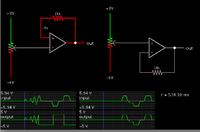anb2020
Newbie level 4
If the ideal (= infinite bandwidth) Opamp exposes output voltage limits, the circuit will also latch to a limit if the input voltage ever touches it.
.
I didn't understand you ..
Can you say it in another way? : )
Follow along with the video below to see how to install our site as a web app on your home screen.
Note: This feature may not be available in some browsers.
If the ideal (= infinite bandwidth) Opamp exposes output voltage limits, the circuit will also latch to a limit if the input voltage ever touches it.
.

So even if the Op-amp is ideal .. Vin doesn't equal Vout ..
Am I right?
J
I re-did the simulation.
Now it behaves correctly but only after the output has gone to either extreme one time. (I wonder if this could be similar to a power-up transient error as mentioned by LvW in post #10?)
Power-on transients aren't observed in a standard transient simulation,.....
Power-on transients aren't observed in a standard transient simulation, also for a real OP with finite bandwidth, because GBW isn't considered in initial transient solution. If you look at the waveforn of the positive feedback circuit falling into saturation, it starts at t=0 after initial transient solution.